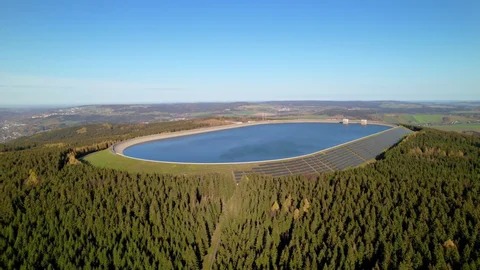In a world where sustainable energy solutions are gaining prominence, it’s essential to understand how various renewable energy technologies contribute to a cleaner, brighter and more sustainable future. One such technology that’s getting significance in the entire renewable energy landscape is pumped hydropower. In this blog, we’ll discuss many emerging questions related to pumped hydropower such as what is pumped hydroelectric power, how does hydropower work etc.
What Is Pumped Storage Hydropower?
Pumped Storage Hydropower is a clean and efficient method of storing energy for later use or we can say, it is a type of hydroelectric power storage. It operates as a giant, rechargeable battery for the grid. It is a cutting-edge energy storage technology that utilizes a pair of interconnected reservoirs that are situated at different elevations.
How Does Pumped Storage Hydropower Works?
During periods of energy surplus, excessive electricity is employed to pump water from the lower reservoir to the higher one, effectively storing potential energy. When electricity demand peaks or renewable sources are inactive, the stored water is released. It flows downhill, driving turbines that generate electricity. Pumped storage hydropower, also known as pumped hydropower storage and pumped hydropower energy, serves as a grid stabilizer, swiftly adapting to fluctuating energy demands. With an efficiency surpassing 80 per cent, it’s an ecologically sustainable storage solution, capitalizing on the natural water cycle. This technology significantly bolsters grid stability and optimizes the utilization of renewable or green hydrogen Energy sources.
Why Pumped Hydropower Storage Is Important For Energy Transition?
Pumped hydropower energy holds immense importance for industries and businesses during the energy transition. It serves as a crucial grid stabilizer, offering rapid-response energy supply during peak demand or fluctuations in renewable power. Pumped hydropower storage enhances grid reliability, ensuring uninterrupted operations for industries sensitive to power interruptions. Moreover, it optimizes the utilization of intermittent renewables, making clean energy available when needed. Pumped hydropower energy is cost-effective and environmentally friendly, aligning with sustainability goals. Industries and businesses can rely on hydroelectric power to meet their energy needs efficiently, reduce costs, and contribute to a greener, more resilient energy landscape during the ongoing transition.
What Is Avaada’s role In Pumped Hydropower Storage?
Avaada Group is well-positioned to capitalize on the potential of pumped hydropower storage projects. With a strong engineering, procurement, and construction (EPC) team and vast experience in setting up some of India’s largest renewable energy projects, Avaada Group is well-equipped to develop and operate Pumped Hydro Storage projects of various scales.
By leveraging their expertise and experience, Avaada Group is committed to delivering sustainable energy storage solutions that meet the highest standards of safety, reliability, and efficiency.
How Much Storage Do We Need For Pumped Storage Hydropower?
The storage capacity required for pumped hydropower varies depending on regional energy demand and renewable energy sources penetration. Typically, larger reservoirs and higher head heights allow for greater energy storage capacity. The flexibility of pumped storage hydro is one of its significant powers, thus it can be even used as an ancillary service of power grids to regulate their frequency.
In real-life application, pumped hydroelectric power storage is among the commercially proven large-scale MES technologies appropriate for approx. 100 MW to a couple of thousand MWs capacities, as per ScienceDirect.
Conclusion
Pumped storage hydro is a cornerstone of the renewable energy company revolution, providing a sustainable solution for energy storage and grid stability. Avaada Group’s commitment to pumped storage hydropower technology ensures that industries and businesses can access efficient energy storage solutions, accelerating the transition towards a greener future.
Frequently Asked Questions About Pumped Storage Hydro
1. Is pumped hydro renewable?
Yes, pumped hydropower is considered renewable because it relies on the gravitational potential energy of water, which is continuously replenished by natural processes like rainfall. Since it relies on the perpetual replenishment of water, pumped hydro is classified as a renewable energy technology, contributing significantly to a cleaner and more sustainable energy landscape.
2. What is the capacity factor of pumped hydropower?
The capacity factor of pumped hydropower typically high, that reflects the efficiency and consistency of energy generation throughout the year. Pumped hydroelectric power plant can rapidly start and stop, allowing them to respond swiftly to shifts in electricity demand. Their high-capacity factor demonstrates their reliability in delivering consistent electricity, making them an asset in maintaining grid stability. This efficiency factor underscores the effectiveness of pumped hydropower as a sustainable energy storage solution, ensuring a steady and reliable power supply even during fluctuating demand and intermittent renewable energy production.
3. How much water is needed for pumped hydro?
The water used in pumped hydropower is recycled between the upper and lower reservoirs, so it does not consume water in the same way as other forms of power generation. Pumped hydroelectric power is a game-changer in the quest for sustainable energy solutions. By partnering with Avaada Group and embracing this innovative technology, industries and businesses can actively contribute to a greener, more sustainable future.








